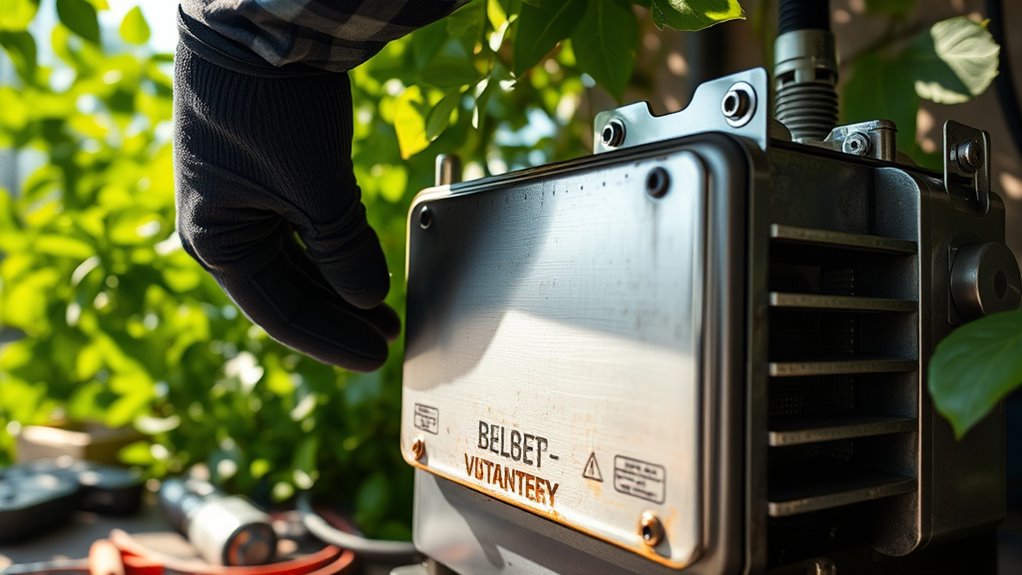To master low voltage output issues in a weekend, start by checking for overloads or wiring faults like loose connections and damaged cables. Consider external factors such as high temperatures, humidity, or dust, which can impact performance. Diagnose your generator with tools like multimeters to identify faulty components. Perform regular maintenance and manage loads carefully to prevent future problems. Keep exploring these strategies to uncover even more ways to troubleshoot effectively.
Key Takeaways
- Perform visual inspections for loose, corroded, or damaged wiring connections and replace or tighten as needed.
- Use a multimeter to check generator or equipment voltage output under load to identify internal faults.
- Examine environmental factors like humidity, dust, or temperature extremes that may impact voltage stability.
- Test and verify the health of batteries, regulators, and other critical components involved in voltage regulation.
- Conduct staged load testing to determine if overloading or wiring issues are causing low voltage output.
Identifying Common Overloads and Wiring Issues

To prevent electrical problems, you need to recognize common overloads and wiring issues that can jeopardize your home’s safety. Overloads happen when your electrical demand exceeds circuit capacity, often caused by connecting multiple high-power appliances to a single circuit or using extension cords excessively. Running devices like air conditioners or space heaters on circuits not designed for such loads is a typical mistake. Faulty, outdated wiring can also restrict current flow, increasing overload risk. Signs include frequent breaker trips, flickering or dimming lights, warm or discolored outlets, buzzing sounds, or burning smells. Overloads can damage appliances, cause overheating, or spark fires. Regularly check your wiring, avoid daisy chaining outlets, and distribute high-power devices across different circuits to reduce overload risks and keep your home safe. Proper wiring maintenance is essential for preventing overloads and ensuring electrical safety throughout your residence. Additionally, ensuring your wiring meets modern safety standards can help minimize these risks and improve overall electrical system reliability.
Examining External Factors and Environmental Impact

External factors and environmental conditions considerably influence low voltage output in generators and electrical systems. At high altitudes, decreased air pressure reduces oxygen, impairing combustion, which weakens power generation and raises engine temperatures, risking instability. Hot environments diminish air density, forcing generators to work harder and causing overheating, which can degrade voltage stability. Conversely, cold temperatures may gell diesel fuel or cause material contraction, affecting connections. High humidity displaces oxygen and accelerates corrosion, leading to increased resistance and voltage drops, while condensation risks short circuits and insulation failures. Dust, dirt, and debris obstruct cooling and promote overheating, and environmental vibrations can loosen connections, causing intermittent voltage issues. Regular maintenance, weather-proofing, and strategic planning help mitigate these external impacts and maintain stable voltage output. Additionally, proper insulation and sealing are essential to prevent moisture ingress and protect components from environmental damage, further ensuring reliable voltage performance. Implementing environmental monitoring systems can also assist in detecting and responding to adverse conditions promptly.
Diagnosing Generator and Equipment Malfunctions

When diagnosing generator and equipment malfunctions, thorough inspection techniques are essential for identifying issues early. Visual and auditory checks reveal abnormal noises, overheating, contamination, or vibration damage. Feel exhaust manifolds to detect uneven combustion or fuel issues. Inspect belts for cracks or looseness, and check connections for corrosion or oxidation. Use a multimeter to verify battery voltage between 13-14 volts; lower readings suggest failure. Measure output current under load—if substantially lower, internal faults are likely. Test the rectifier’s AC output if applicable. Mechanical assessments include inspecting bearings for wear, cooling system performance, and belt tension. Vibration monitoring helps detect misalignment or mechanical faults. Understanding the contrast ratio of your equipment can also provide insights into potential image quality issues that may affect performance diagnostics. Combining these methods ensures thorough diagnostics before further repairs.
Implementing Preventive Maintenance and Proper Load Management

Implementing preventive maintenance and proper load management is essential for maintaining stable voltage output and extending equipment lifespan. Regularly inspect and clean critical components like air filters, fuel systems, and cooling units to prevent dirt buildup that impairs performance. Tighten wiring connections and check for corrosion to ensure reliable voltage regulation. Replace worn parts, such as automatic voltage regulators, promptly to maintain stability. Proper load management involves calculating the connected load accurately to prevent overloading, which causes voltage drops. Staged load application and power factor correction help stabilize voltage during large or sudden demand changes. Protect equipment from environmental factors like dust, moisture, and extreme temperatures by installing in suitable environments. Regular maintenance reduces unexpected faults and keeps voltage levels consistent. Additionally, establishing a scheduled maintenance plan helps identify potential issues early before they lead to shutdowns. Recognizing Load Variations and their impact on voltage stability allows for more effective preventive strategies.
Utilizing Diagnostic Tools for Accurate Voltage Assessment

Utilizing diagnostic tools effectively is essential for accurately evaluating low voltage issues in electrical systems. You need the right equipment to pinpoint faults quickly and reliably. Digital multimeters measure voltage, current, and resistance precisely, while non-contact testers detect voltage without contact, improving safety. Advanced testers like Power Probe offer learning modes and visual/audible alerts, making diagnostics more efficient. Use extendable cables for hard-to-reach points, and activate components to test under load. Proper use of these tools helps identify issues like corrosion, poor grounding, or faulty relays. To keep your diagnostics organized, consider this overview:
| Tool Type | Key Feature |
|---|---|
| Circuit Testers | Voltage, resistance, continuity detection |
| Multimeters | Precise measurement of voltage, current, resistance |
| Non-contact Testers | Safe, contactless voltage detection |
| Advanced Diagnostic Tools | Load testing, audible/visual alerts, component activation |
A thorough understanding of electrical system components enhances troubleshooting accuracy and prevents future issues.
Frequently Asked Questions
How Can I Safely Test Voltage Levels Without Risking Equipment Damage?
To safely test voltage levels without risking damage, you should use proper testing equipment like multimeters, non-contact voltage testers, and low voltage testers designed for sensitive circuits. Always verify instruments are functional before use. Follow safety protocols such as Lockout/Tagout, wear PPE, and conduct visual inspections beforehand. Employ operator safety features like palm switches and interlocks, and systematically confirm circuit de-energization with precise measurements to prevent equipment damage.
What Are Signs of Internal Transformer Failure Beyond Low Voltage Output?
You’ll notice internal transformer failure signs beyond low voltage output if you hear humming, buzzing, or popping sounds, which indicate winding faults or loose laminations. A burning smell suggests insulation overheating. Oil leaks, corrosion, or deformities point to mechanical issues. Thermal signs like hotspots or overheating, combined with voltage fluctuations or breaker trips, reveal internal problems. Conducting visual inspections, insulation tests, and gas analysis helps confirm these internal faults early.
How Does Ambient Temperature Specifically Influence Wiring Resistance?
You should know that a 20°C increase in temperature can raise copper wiring resistivity by about 20%. Ambient temperature directly influences wiring resistance because higher temperatures cause metals like copper to expand and resist electron flow more, leading to increased resistance. This results in voltage drops and reduced efficiency. Conversely, cold temperatures stiffen insulation, increasing brittleness. Managing temperature effects guarantees ideal wiring performance and longevity in any environment.
Which External Environmental Factors Most Commonly Cause Sudden Voltage Drops?
Lightning strikes are the most common external factors causing sudden voltage drops, as they induce spikes followed by dips in power. Heavy winds and storms can damage power lines or external infrastructure, leading to voltage fluctuations. Fallen trees or debris physically impair lines, causing interruptions. Additionally, external faults or faults in the utility network, such as short circuits, can cause abrupt voltage drops, disrupting your electrical system unexpectedly.
What Maintenance Schedule Best Prevents Low Voltage Issues in Aging Systems?
Did you know that regular maintenance can reduce low voltage issues by up to 60%? To prevent problems in aging systems, you should schedule inspections and cleaning at least annually, or more frequently if environmental conditions demand. Perform insulation tests, check for loose connections, and monitor operational data consistently. Adjust your schedule based on usage and environmental factors, and keep detailed records to identify early signs of wear, ensuring reliable voltage output.
Conclusion
By mastering these troubleshooting steps, you’ll quickly pinpoint low voltage causes—whether it’s overloads, wiring, or environmental factors. Think of it like a seasoned blacksmith wielding a hammer and anvil, fine-tuning your system with precision. Keep up with preventive maintenance and leverage diagnostic tools to stay ahead. With practice, you’ll tame your generator’s quirks faster than a knight drawing his sword, ensuring reliable power when you need it most.









